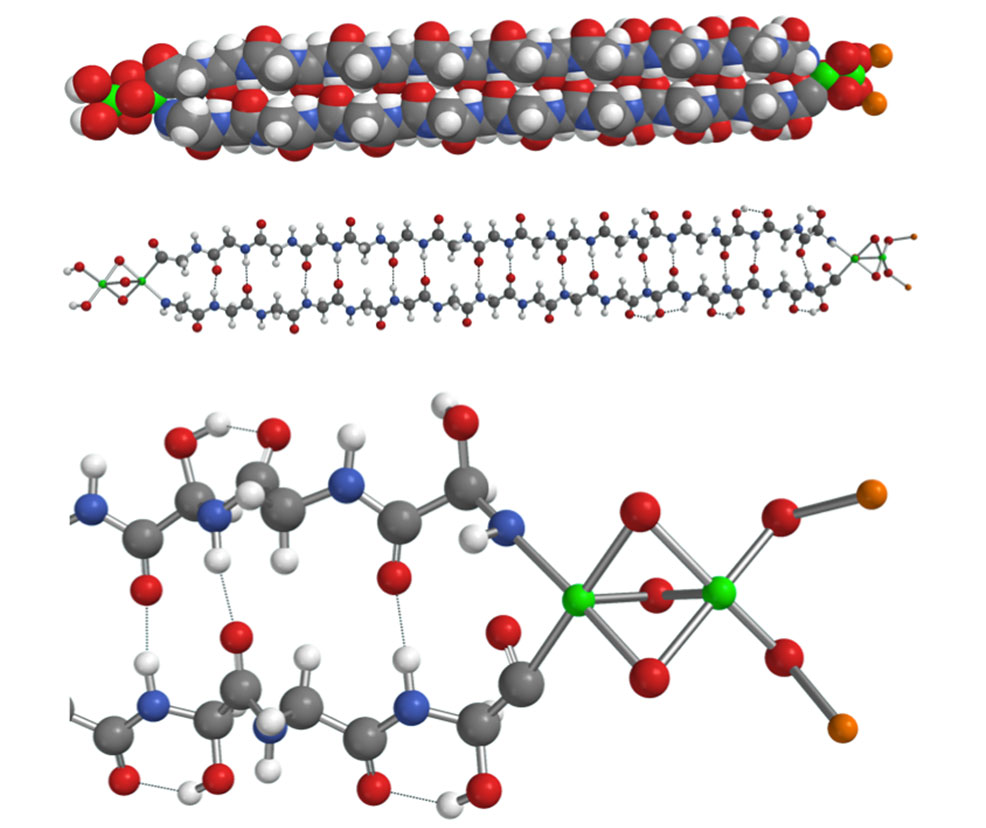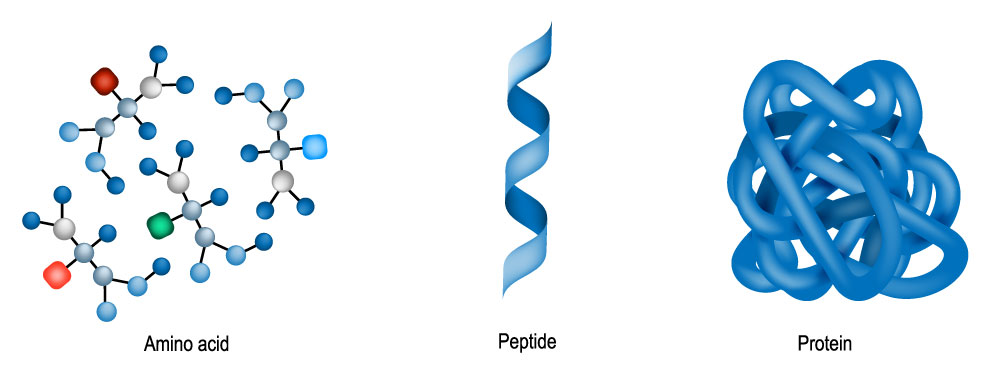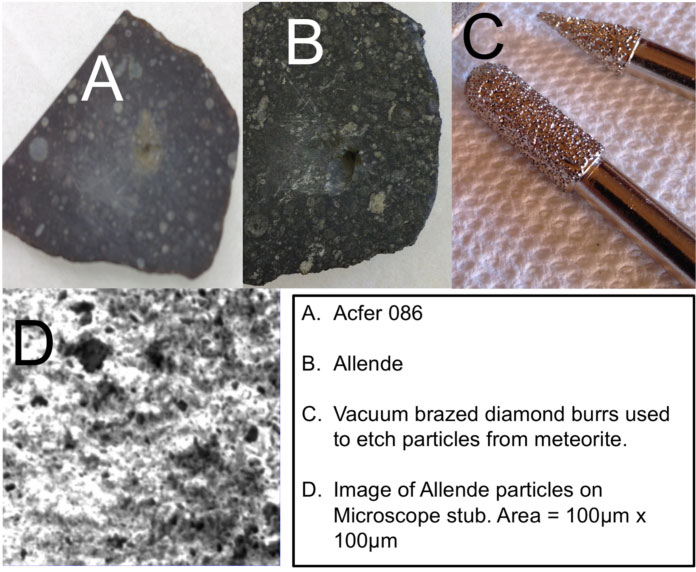
5th March 2020 Protein discovered in meteorite? Scientists from Harvard University, along with physics and biotech companies PLEX Corporation and Bruker Scientific, have published details of what they believe is the first known meteorite to contain a protein. The molecule has been named hemolithin.
Model of hemolithin molecule after MMFF energy minimization.
While nobody can know for sure how life began, scientists have several good theories. Some believe a primordial "soup" of organic molecules on the young Earth may have been triggered by lightning bolts, which enabled larger and more complex molecules to form over millions of years. Another popular idea is deep-sea hydrothermal vents, which could have served as incubators, enabling just the right chemical reactions and thermal dynamics. Yet another possibility is that the pre-biotic building-blocks of life originated in space, and were distributed to planetary surfaces where life then emerged. Amino acids are small but biologically vital compounds, believed to have played a major role in the earliest stages of evolution. About 500 naturally occurring types are now known, which contain amine and carboxyl functional groups, along with a side chain structure that varies between types. Their key elements are carbon (C), hydrogen (H), oxygen (O), and nitrogen (N). Certain amino acids can be genetically combined into short chains known as peptides. However, this is only naturally possible for about 20 of the 500 known types. Peptides consist of two or more amino acids, linked by peptide (amide) bonds. They can be further classified as oligopeptides and polypeptides. The former typically have between two and 10 amino acids, while the latter contain 10 to 50 amino acids (though definitions vary among the scientific community with some researchers preferring an upper limit of 100). Having begun with amino acids, combining into peptides, the next level of complexity we encounter is proteins. Again, the definitions vary – but a protein is usually agreed to consist of more than 50 amino acids.
While polypeptides shorter than 40-50 amino acids in length do not fold into a fixed structure, proteins can do so. The ability to form stable, 3D structures allows proteins to perform important functions in living organisms. Haemoglobin, for example, is a protein carried by red blood cells that picks up oxygen in the lungs. Peptides with less than 40-50 amino acids, by contrast, do not have enough cooperative interactions to form a stable structure. Amino acids found in carbonaceous meteorites have been studied for the last 50 years. More recently, researchers discovered new types. Other molecules necessary for life are now also confirmed to exist within these rocks. Ribose, for example, is a sugar found in RNA, a polymeric molecule essential for genes. Alongside this, researchers have identified meteorites with compounds of iron, cyanide, and carbon monoxide that resemble the active site of hydrogenases – enzymes that provide energy to single-celled microorganisms, and may have helped power life on the early Earth. These have provided fresh insight into the mechanisms of extraterrestrial synthesis of organic compounds. Now, scientists report a potentially even greater discovery: the first known protein in a meteorite. Hemolithin – the name given to this molecule – is ostensibly an iron, oxygen and lithium-containing protein. It was found inside Acfer 086, a carbonaceous chondrite Allende meteorite discovered in Algeria back in 1990. This rock had been analysed previously, showing that it contained amino acids.
By using a higher precision technique called matrix-assisted laser desorption ionization (MALDI), a team from Harvard University along with physics and biotech companies PLEX Corporation and Bruker Scientific produced more advanced measurements, revealing the glycine (amino acid) with a stronger signal than before. Not only that, but it was seen to be bound with iron, oxygen and lithium, together forming what appeared to be a protein. The atom groupings on the tips of the protein form an iron oxide, the researchers note, observed in prior research to absorb photons – a means of splitting water into oxygen and hydrogen. This can produce an energy source that would also be necessary for the development of life. Analysis of the full spectrum of isotopes confirmed an extra-terrestrial origin. Its very high ratios of deuterium/hydrogen are not found anywhere on Earth, but are consistent with long-period comets – suggesting that the protein was formed in the proto-solar disc or perhaps even earlier, from interstellar molecular clouds that existed long before the Sun's birth. "I think this is really exciting," said astronomer and chemist Chenoa Tremblay from CSIRO in Australia, who was not involved in the research. "I think that it's got a lot of really interesting implications and a lot of compelling arguments. And I think it's a really great step forward." Others are more sceptical. Jeffrey Bada, an American exobiologist and chemist known for his studies on the origin of life, commented: "The main problem is the occurrence of hydroxyglycine, which, to my knowledge, has never before been reported in meteorites or in prebiotic experiments. Nor is it found in any proteins. Thus, this amino acid is a strange one to find in a meteorite, and I am highly suspicious of the results." The paper – which appears on arXiv, and has yet to be peer reviewed and published – is generating much discussion in the scientific community. With a mass of just 2320 daltons, hemolithin lies at the lower end of what would be considered a true protein and is placed only slightly above TRP-Cage, the smallest known folding protein, which is only 2169 daltons (for comparison, most proteins are about 20 times heavier). If confirmed, however, this discovery would prove that Earth is not the only place where proteins exist – and may increase the probability of life elsewhere in the universe. NASA's OSIRIS-REx spacecraft is currently orbiting Bennu – a carbonaceous asteroid in the Apollo group – in preparation for a surface landing. This could provide new opportunities to study the building blocks of life, perhaps including more evidence of proteins, when it returns the samples to Earth in 2023.
Comments »
If you enjoyed this article, please consider sharing it:
|









